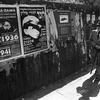The Strange Case Of The Missing Durers
Poland is putting new pressure on America's Cleveland Museum of Art and other major museums to return a widely dispersed collection of Albrecht Durer drawings looted by the Nazis during World War II.
The 27 drawings, three of which are owned by the Cleveland museum, were removed by Nazi officers in 1941 from the Ossolinski Institute in the city of Lviv, which was then in Poland. It became part of Ukraine when the United States and its allies moved the border after the war.
The U.S. Military Government in Germany rediscovered the Durer drawings in a salt mine in Austria after the war and later returned them to Jerzy Lubomirski, a descendant of the Polish prince who had originally donated them to the Ossolinski Institute in the 19th century. Lubomirski later sold the drawings to collectors and art museums around the world.
In a new book circulated among American art museums over the past month, Polish scholars have compiled legal documents proving, they say, that the U.S. government should not have given the drawings to Lubomirski as a private individual. Instead, the scholars say, the drawings should have gone back to the Ossolinski Institute, which relocated to Wroclaw, Poland, after the war.
The drawings are highly valuable because of their rarity and because Durer (1471-1528) was one of the greatest masters of the Renaissance.
"We would like to resolve this in an amicable way, a reasonable way, and have this done as friends do," Boguslaw Winid, deputy chief of the Polish Embassy in Washington, D.C., said yesterday.
Poland won't sue to get the drawings back, Winid said. Instead, the government is using moral pressure, and a dash of publicity surrounding the new book, to reopen negotiations with museums including the Cleveland Museum of Art, the Metropolitan Museum of Art in New York and the Nelson-Atkins Museum of Art in Kansas City, Mo.
Winid said that as an ally of the United States in the war against terrorism, Poland deserves to be heard anew on the question of the Durers.
"Thousands of our troops are in Iraq, and some have been killed in action," Winid said. "We believe this should be taken into consideration when we have unresolved issues from the Second World War."
Katharine Reid, director of the Cleveland museum, said, "We've received the claim, and we are in the process of making our review. If we find that there's any new information, we would respond accordingly. But we have yet to study the claim."
Michael Horvitz, chairman of the Cleveland museum's board, said the newest thrust by Poland "is part of a long chain of developments in a very confusing history."
Part of the problem is that the Stefanyk Scientific Library in Lviv, Ukraine, also believes it is the rightful owner of the Durers because the drawings once resided in that city. A spokesman at the Ukrainian Embassy in Washington did not return calls Tuesday seeking comment.
The ownership history of the Durers is complex. The two dozen drawings were collected originally by Prince Heinrich Lubomirski, who donated them in 1823 to the Ossolinski in Lviv, then the Austrian city of Lemberg.
The collection was housed within the Lubomirski Museum, part of the institute. When the Austro-Hungarian Empire collapsed after World War I, Lviv became part of Poland.
The drawings were looted by the Nazis from Lviv and buried in the Austrian salt mine toward the end of World War II. After the war, Jerzy Lubomirski persuaded U.S. forces to return the drawings to him. Gradually, the drawings appeared on the art market. Cleveland bought "The Dead Christ" and "The Ascension" in 1952. In 1963, it acquired its third Lubomirski Durer drawing, "Head of a Man in a Cap."
The new book on the drawings, called "The Fate of the Lubomirski Durers," has been published by the Society of the Friends of the Ossolinski Institute with additional funding from the American Council of Polish Culture. It includes statements by Lubomirski descendants who say the drawings belong back in Poland.
"The Ossolinski Institute decided it's time to get this out to the world and remind the current holders of the works that their provenance is not clear," said Thaddeus Mirecki of Washington, D.C., an American citizen who helped edit the new book. "We need to make the current holders understand that they don't have clear title."

 Kawaleria Szarza Smaku
Kawaleria Szarza Smaku
 Europejska
Europejska
 Krakow Pinball Museum
Krakow Pinball Museum






